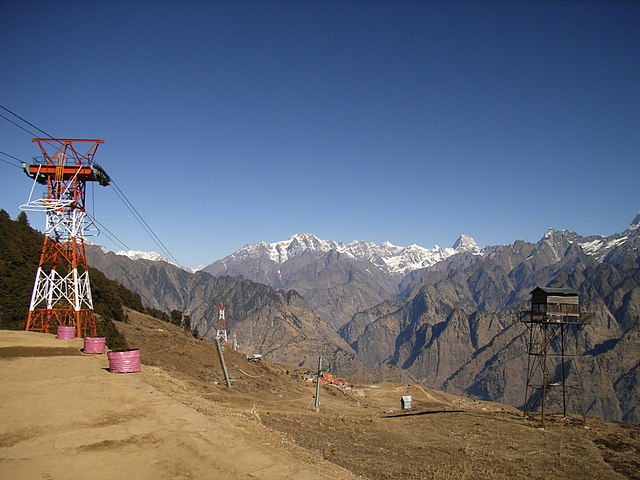|
India Counts Cost of Disasters in Himalayas Amid Infrastructure Push and Climate Change

Ropeway at Joshimath, Uttarakhand - 1 February 2007 (Public Domain)
December 27, 2023 4:03 AM
Anjana Pasricha
New Delhi —
Lila Devi’s family built a new home after their house in Khanyara village in the Indian state of Himachal Pradesh collapsed when intense rains lashed the Himalayan mountains this summer.
They moved to lower slopes where they own a patch of land – they had to sell a part of it to fund the new home. They hope they will be safer if a flash flood inundates their village again, but memory of the torrent of water and debris that coursed down the hill still haunts them.
“We keep praying to God that this never happens again. Does anyone want to abandon their home?” said Devi. Her brother-in-law is equally apprehensive. “I am frightened to even venture up the hill because I witnessed the deluge with my own eyes,” said Ramel Singh.
They were among thousands impacted by a series of unprecedented disasters that ravaged India’s Himalayan region this year. The devastation has raised questions whether large-scale infrastructure development along with the impact of climate change is making the mountains more disaster-prone.
In Joshimath town, hundreds of people were evacuated from houses that developed huge cracks when land began sinking in January. In the monsoons, heavy rains unleashed landslides and floods that swept away roads and buildings in several towns and villages. In October, a glacial lake in Sikkim state overflowed, flooding many villages. Last month, 41 men were trapped in an under-construction road tunnel for 17 days.
In recent years, India has fast-tracked construction of highways, hydroelectric dams, bridges and rail lines in the Himalayan mountains. Environmentalists point out that hillsides are being blasted, tunnels drilled and trees cut at a time when global warming is bringing more intense bursts of rain and causing glaciers to melt.
“Climate change is a force multiplier. These projects when they were planned had not taken climate change into account,” said Anjal Prakash, a research director at the Bharti Institute of Public Policy at the Indian School of Business in Hyderabad.
“What if 250 millimeters of rain falls in just two days which is the order of the day now in the Himalayas? That means the road infrastructure, the tunnel infrastructure must adhere to these new realities, the new normal that we have.
Development is needed in the Indian Himalayas – home to 50 million people. Dams ramp up clean energy and light villages, while roads cater to an ever-growing influx of tourists, boost local economies and create livelihoods.
Highway construction is also a vital strategic project – India is accelerating road construction to ferry troops and military equipment to India’s tense border with China where tens of thousands of soldiers remain deployed for a fourth year.
But local communities fear that the infrastructure push is destabilizing the mountains. In Joshimath town, where homes developed cracks, some residents said that the rampant construction had caused the land to sink.
Joshimath resident, Vikesh Sikri, who runs a hotel close by, said while schools and roads are necessary, more caution is necessary. “Tinkering too much with the mountains will make them loose and crack or damage hillsides,” he said.
Last month the spotlight turned on a flagship project of Prime Minister Narendra Modi’s government – a 900-kilometer all-weather network of roads being built to improve connectivity to four Hindu pilgrim sites in the Himalayas. The 41 men who were trapped in a road tunnel before being rescued had been working on the project.
Some environmental groups had raised questions about the viability of the two-lane road that will wind through high mountains.
“The road will go through some areas about which we have limited understanding,” according to Rajneesh Sareen, Program Director of the Sustainable Buildings and Habitat Program at New Delhi’s Center for Science and Environment. “The variation in environment within just two to three kilometers in the mountains can be huge. Detailed studies have not been done in some of these areas, so how do we assess the likely impact of construction?”
Environmentalists say there is no time to lose in switching to more sustainable development in mountain ranges that are warming faster than other parts of the planet.
“Climate change is striking us very fast. The window of opportunity is only 10 to 15 years. If we don’t put our act together, we will have a much bleaker future,”
according to Prakash.
The climate crisis that the Himalayas are facing also got attention at the Cop28 climate summit held in Dubai earlier this month.
“It is deeply shocking to learn how fast the Himalayan glaciers are melting. And deeply distressing to hear first-hand from local communities about the terrible impact on their lives,” United Nations Secretary General António Guterres said. His comments followed a visit he made to Nepal last month.
In India, those who have seen their mountain homes collapse, like Lila Devi's family, are apprehensive. “I worry that our new home might get flooded. People say that might happen when the rains come,” said Swarna Devi in Khanyara village.
Echoing her concerns, her father-in-law, Ramel Singh, pointed to the mountains around. “This is where we want to stay because these hills have been our home for generations.” Copyright © Dec 2023 Voice of America. All Rights Reserved.
Back To Country Profile
|